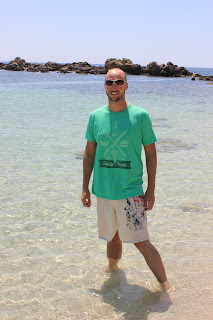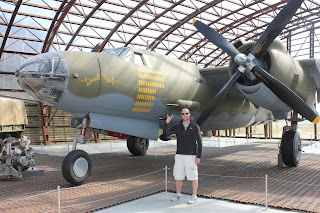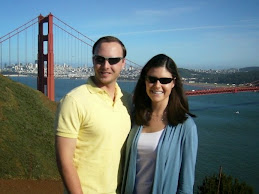After a busy May and June, David and I were planning on
spending the next couple of months relaxing at home in London. Our plans quickly changed when we realized
that David only has a few more baseball games left until the playoffs in September. That opened up a lot of weekends for us!
Inspired by the WWII trip Dad and Uncle Paul took across
Europe last spring, I started to look into going to Normandy for a few days. Jordan had also mentioned to us before that
he really wanted to see the D-Day sites across Northern France, and since he
was planning on being in the states most of August for work and his brother’s
upcoming wedding, we had to quickly plan a trip for July!
On Thursday evening, we drove down to Portsmouth to get on
the overnight ferry to Caen. The journey
was a little over 7½ hours, leaving England at 10:45 and arriving in France at
7:30 the next morning.
Leaving Portsmouth Harbor - We crossed the English Channel
the same as the D-Day troops, from Portsmouth to the area around Caen. The ride over was smooth for us, but due to
bad weather and big breakfasts, the boat trip for the troops couldn’t have been
more different. They were violently
seasick and lost so much energy before even landing, that the ones that did
make it across the beaches had to rest in the safety of the sea-wall before
moving on. Some of the British on Sword
beach even stopped to brew cups of tea, while the beach was still under fire!
Because I had to work the next day and the guys wanted to
get the most out of the morning, I made sure to book us a sleeping cabin so we
could rest up. When we first walked into
our cabin, we only saw the two bottom beds and panicked. But then David figured out that the top bunks
came out of the ceiling. So clever!
Once we got to shore, we started to drive to Bayeux. David had been to Normandy before when he was
a teenager, so he recommended that we stay in Bayeux. It’s a medieval village in the middle of the
major WWII Normandy sites. The village
was spared by bombers (unlike surrounding towns such as Caen) so it has retained
much of its charm. Plus David loves the
Bayeux Tapestry and wanted to ensure that we spent some time at the museum
viewing the fabric.
The 3G on our phones did not work in France and we did not
have a GPS, so I had printed off Google Map directions for us. But almost immediately, we were lost. Much like England, there are hardly any
street signs in France and the signs to Bayeux were pointing in a different
direction than Google was telling us. One
of the issues was the on/off ramps of the freeways. When we were finally on our way, we had to
stop and get gas and when we tried to get back on the main road, we couldn’t
and ended up going half an hour out of the way just to get back to the freeway.
But one of the good things about getting lost is stumbling
upon interesting sites we didn’t expect to see – like Pegasus Bridge.
On June 5, the night before D-Day, the British flew in to
seize the bridges near one of their assigned beaches, Sword. This would prevent the Germans from either
blowing the bridges up or crossing them to attack the men landing the next
morning. The bridge was captured, but
British officer Den Brotheridge was shot through the neck running across, and died. He is considered the first Allied casualty to
be killed on D-Day.
After nearly two hours of driving around Caen, and with an
estimated journey time of only 30 minutes, we had arrived at our hotel in
Bayeux, the Château de Bellefontaine.
If you look closely, you can see both the French and
American flags hanging above the door. I
had never seen so many American flags outside of the states before. Every town that we stopped in along the coast
was flying the stars and stripes – in town squares, memorial sites, and even in
people’s front yards. To this day, the
French are still so grateful to the Americans for helping to liberate their
country.
One of the great things about working in the Finance
department at Dell is that during the summer, our CFO gives his employees
“Summer Hours” to encourage them to spend more time with friends and family. So between May and September, if I finish all
of my work for the week, I can log off at 2:00 on Fridays.
So while I worked through the morning and early afternoon,
David and Jordan checked out Arromanches.
Arromanches is the site of the artificial harbor built by
the Allies to get supplies and men onto the continent during the final stages
of the war. Today, the foundations of
the harbor are still visible in the water.
Later that afternoon, once I was finished with work, all three of us headed to Utah Beach. On the way, we stopped at Angoville au Plain to see the church where two US medics from the 101st Airborne (paratrooper) Division spent the night tending to 80 people, including American and German soldiers, civilians, and one child. Bloodstains from that night are still visible in the pews.
We also stopped at St Mere Eglise, the first town to be
liberated, to see the famous church from ‘The Longest Day.’ Though we haven’t seen the movie, we all knew
the story of Private John Steele, a paratrooper whose chute caught on the
church tower. Though stuck paratroopers
were easy targets for the enemy, John pretended to be dead for hours while the
battle for the town raged around him and the church bells partially deafened
him. He was eventually cut down and
taken prisoner by the Germans.
An effigy
of Steele hangs from the church bell tower,
and inside, the stained glass window at the back commemorates the paratroopers.
Utah Beach was one of my favorite parts of our tour of
Normandy.
It wasn’t until we visited the beach that we realized just how
treacherous the landings were. The
landing craft came in during low tide on the morning of June 6th so that all of
the obstacles, like mines, were visible.
But during these periods, the beaches are incredibly wide! The craft didn’t land right on the beaches
either, so the men had to wade through the water and then make it all of the way across that long stretch of sand.
We learned a lot at the museum on the beach. The museum was commissioned by Michel de
Vallavieille, the former mayor of nearby town, Sainte Marie de Mont. Michel was a French boy badly wounded on June
6th. He was evacuated to England and
stayed there until the following year, giving him time to recover. He established the museum to honor the veterans
of Normandy.
David standing in front of David Dewhurst Jr.’s B26 bomber, ‘Dinah
Might.’ David Dewhurst Jr., a fellow
Texan, flew 85 successful missions over Europe, including Utah Beach. There is a video in the museum featuring his
friends and colleagues, praising him for keeping calm under pressure (even when
his plane was hit and damaged) and altogether being a stand-up guy. Sadly, he died in a car accident a year after
returning home from the war. His son,
David Dewhurst III, was also in the Air Force, a CIA officer, and is the current Lt
Governor of Texas.
The next day, we continued our tour with an official guide,
Francois. There were five other
Americans on the tour with us, an American woman from Paris and an elderly
couple from Florida with their grandkids.
These children, a 12-year-old boy and a 10-year-old girl,
were so interested in the
history of WWII and the various sites. I
couldn’t believe my ears when the little boy told us that his favorite thing in
London was the RAF (Royal Air Force) museum.
The little girl spoke up and said that the Harry Potter movie studio
tour was her favorite, but she equally surprised us when we asked if they play
any sports and she stated that she’s a contortionist.
Who were these kids?!
It gave me hope that future generations will continue to want
to learn about this part of our history, and be interested in visiting the old
battlegrounds.
Our first stop was Pointe du Hoc, the cliffs between the
American sectors of Utah Beach and Omaha Beach.
An elite squadron of Rangers under Colonel Rudder was tasked with
scaling the cliffs to destroy the German guns located there. There were five guns total that had the long-range
ability to reach Utah and Omaha, which would have been disastrous for the
troops landing on those beaches.
Fortunately, the Rangers were able to scale the cliffs with their rope
ladders and grapples and successfully took the area. It came at a heavy cost. By the end of the fighting, 135 out of the original
225 men were dead, wounded, or missing.
The sheer cliffs around Pointe du Hoc
A partially destroyed bunker
The bombardment of Pointe du Hoc must have been incredible
judging by the numbers of craters we saw.
The Germans were attacked from bombers overhead, as well as the naval
ships out at sea.
French girls running through the craters. Francois told us that as a little boy, he
used to play war in the craters with his friends. All of the local boys wanted to be American
Rangers so they forced the girls to be German soldiers. It wasn’t until the mid-80’s, when D-Day
soldiers started getting older and dying, that tourists began arriving. They said that their fathers and grandfathers
never talked about the war, so they wanted to learn more about the events that
took place and see the battle sites for themselves.
The two grandparents in our group corroborated Francois’s
story, by stating that both of their fathers were in WWII – one in the Pacific
as an engineer and another was a paratrooper in Europe. Both never, ever talked about the war and had
a hard time adjusting to civilian life when they returned because there was
nothing as exciting and stimulating as being at war. Nothing back home could compare to it. Their stories reminded me of the end of 'Hurt Locker,' when Jeremy Renner is standing in the cereal aisle of the
supermarket, staring at the dozens of different varieties. It must be incredibly hard to go from making
life or death choices to making mundane decisions like what kind of cereal to purchase.
After Pointe du Hoc, we drove along the coast to Omaha
Beach.
Again, this is a huge stretch of land the soldiers needed to cross
Unlike the landing at Utah Beach, Omaha was a complete
disaster. Nothing went according to plan
and the casualties there were appalling compared to the 200 or so men that died
at Utah. Thousands lost their lives, yet
we only noticed one memorial dedicated to the National Guard. The locals were paddle-boarding in the water
and there were dogs playing fetch along the beach. It looked like a completely normal beach,
unless you spotted the German pillboxes hidden in the hillside brush.
Luckily we had Francois with us to show us photos and
explain how the invasion worked. I am
also reading Antony Beevor’s D-Day: The Battle for Normandy, so I had a lot of
background information.
Francois and his
family have lived in the Normandy region for ages, so it was also interesting
to hear his perspective on the war. He
told us that his grandmother lived in Caen and was there during the bombardment. Until the day she died, whenever there was a
lightning and thunderstorm, she was absolutely terrified. And although 15,000 civilians died in the
area, she and others always told Francois that it was the price they had to pay
to get their country back.
From Omaha, we headed to the American cemetery. During the war, families of fallen soldiers
were given the choice to have the bodies of their loved ones brought back to
the US or buried in Europe. 40% elected
to burial in Europe. There are over
9,000 men and women in the American cemetery of Normandy, and all of them (except
one) from WWII.
The exception is Quentin Roosevelt. He was killed during WWI but his body was
moved to be next to his brother’s, Teddy Roosevelt Jr. At 56, Teddy Roosevelt Jr. was the oldest man
to land on the beaches during D-Day (he had to petition his commanding officer to
let him take part in the first wave of Utah after being denied). About a month later, he died of a heart
attack.
Among the rows and rows of marble crosses, there are a few
Star of David markers for the Jewish men that died during the campaign. However, it will never be known how many of
the soldiers buried there were actually Jewish because it was not uncommon for Jews
to officially enlist as Christians, in case they were captured by the Germans.
The cemetery also has a chapel, and a wall of the missing containing
1,557 names. Rosettes next to the names
mean that the body of the solider has since been found. Francois did tell us that remains are still
being found, as Normandy is mostly vast farmland and empty fields. Equipment, even mines, have also been
discovered.
The cemetery was a really sobering and emotional place. Set in a peaceful park above Omaha beach, it
is a beautiful final resting place overlooking the sea.





































































